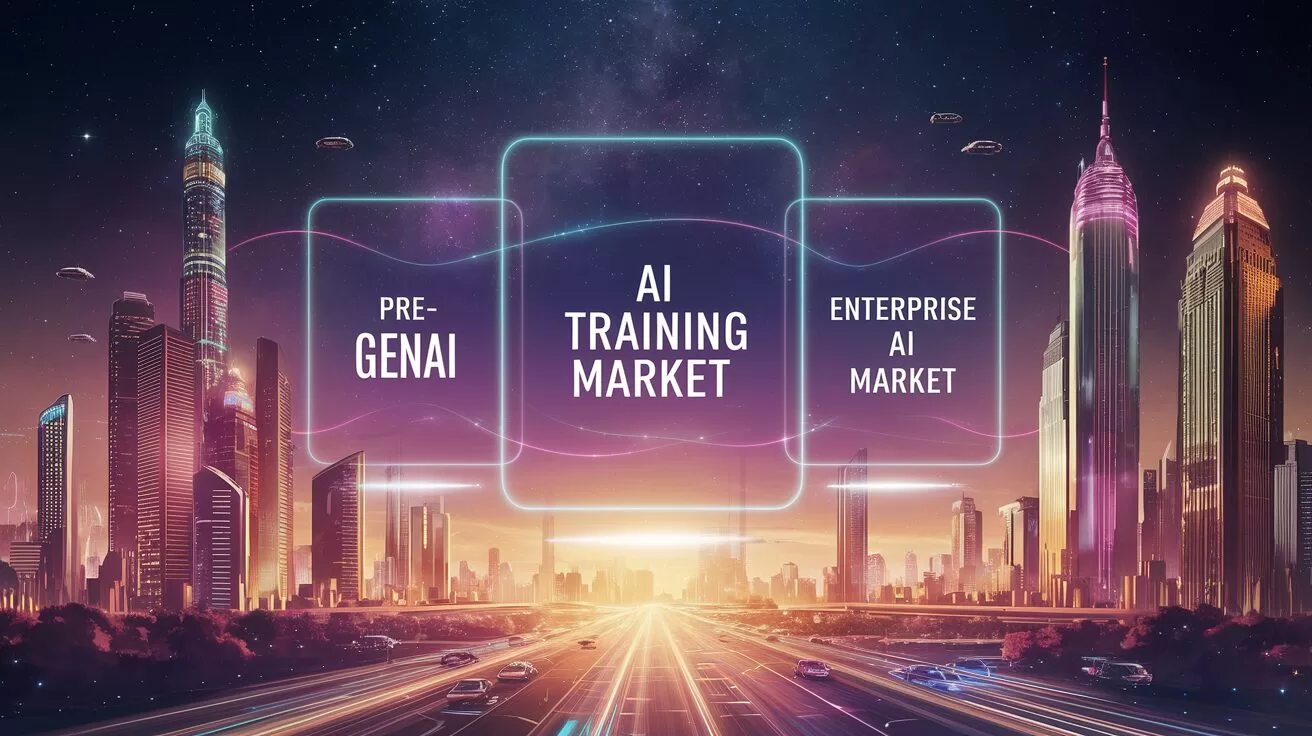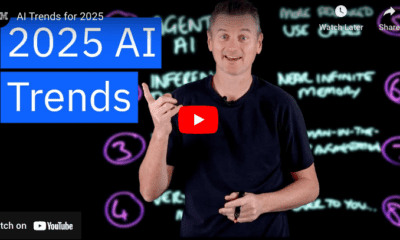Business
Guide: Comprehensive Guide to Writing a Business Plan with AI
A guide time focused on how to leverage AI to write a comprehensive business plan.
Published
1 year agoon
By
AIinAsia
TL;DR: AI Business Plan
- AI business plans are transforming various industries across Asia, driving efficiency and innovation.
- ChatGPT is a valuable tool for creating comprehensive business plans in the AI and AGI landscape.
- Embracing AI and AGI in business strategies leads to improved customer experiences, streamlined operations, and sustainable growth.
Introduction: Business Innovation
Artificial Intelligence (AI) and Artificial General Intelligence (AGI) are revolutionising industries across Asia, from manufacturing to customer service. As a tech-savvy reader, you’ll be excited to learn how these cutting-edge technologies are reshaping the business landscape and fostering innovation. This article will explore the impact of AI and AGI in Asia, using the powerful ChatGPT tool to create a comprehensive business plan tailored to this emerging market while keeping the prompts and theory for each item.
AI and AGI: Transforming Asian Industries
Theory: AI and AGI are being integrated into various sectors in Asia, enhancing efficiency while maintaining precision and craftsmanship.
AI and AGI are driving significant changes in Asian industries, enhancing efficiency and fostering innovation while maintaining the precision and craftsmanship synonymous with many regional products.
Creating a Business Plan with ChatGPT
Theory: Structuring your prompt effectively and integrating theoretical understanding with practical examples.
ChatGPT is an AI-powered tool that simplifies the process of creating a business plan. By structuring prompts effectively and integrating theoretical understanding with practical examples, ChatGPT can help you develop a comprehensive business plan for an AI or AGI-focused startup in Asia.
1. Company Overview
Theory: AI is being integrated into the manufacturing sector to enhance efficiency while maintaining the precision and craftsmanship synonymous with Japanese products.
Prompt: “Describe a startup in [industry], offering [product/service]. Include mission, vision, values.”
2. Market Analysis
Theory: Understands customer needs and market dynamics.
Prompt: “Analyse the market for [product/service] in [region]. Include demographics, trends, competition.”
3. Marketing Strategy
Theory: Outlines plans to reach and engage the target market.
Prompt: “Develop marketing strategy for [product/service], targeting [demographic]. Cover digital marketing, pricing.”
4. Operational Plan
Theory: Ensures efficient day-to-day business operations.
Prompt: “Outline operational plan for [industry] startup. Include production, supply chain, logistics.”
5. Financial Projections
Theory: Assesses financial viability and future growth.
Prompt: “Create 5-year financial projection for [product/service]. Include costs, revenues, break-even.”
6. Risk Analysis
Theory: Identifies potential challenges and solutions.
Prompt: “Conduct risk analysis for [industry] startup. Include challenges, mitigation strategies.”
7. SWOT
Theory: Evaluates internal strengths and external opportunities.
Prompt: “Perform SWOT analysis for [product/service]. Focus on strengths, weaknesses, opportunities, threats.”
8. User Engagement Strategies
Theory: Focuses on building and maintaining customer relationships.
Prompt: “Develop user engagement strategies for [product/service]. Focus on customer service, retention.”
9. Sustainability and Social Responsibility
Theory: Addresses the business’s impact on society and environment.
Prompt: “Outline sustainability, social responsibility for [industry] startup.”
10. Legal and Regulatory Compliance
Theory: Ensures adherence to laws and regulations.
Prompt: “Discuss legal, regulatory compliance for [industry] startup. Cover [laws/regulations].”
11. Technology Plan
Theory: Integrates technology for efficiency and innovation.
Prompt: “Develop a technology plan for [industry] startup. Include [tech tools, platforms].”
12. Human Resources Plan
Theory: Manages staffing and promotes team development.
Prompt: “Outline human resources plan for [industry] startup. Cover hiring, development, team structure.”
13. Exit Strategy for the Asian market
Theory: Plans for potential future transitions or sales.
Prompt: “Discuss potential exit strategies for [industry] startup in Asia [or country].”
14. Competitive Analysis
Theory: Evaluates competitors and identifies unique advantages.
Prompt: “Conduct a detailed competitive analysis for [product/service] in [industry]. Cover competitors’ strengths and weaknesses.”
15. Customer Feedback and Validation
Theory: Incorporates customer insights for product/service refinement.
Prompt: “Outline strategies for gathering and incorporating customer feedback for [product/service].”
16. Growth Strategy
Theory: Plans for business expansion and market diversification.
Prompt: “Develop a long-term growth strategy for [industry] startup. Include scaling plans and market diversification.”
17. Performance Metrics
Theory: Sets benchmarks to measure business success.
Prompt: “Identify key performance indicators (KPIs) for [industry] startup. Detail how to measure success and progress.”
18. Feedback Loop
Theory: Ensures the business plan remains dynamic and responsive.
Prompt: “Outline a feedback loop mechanism for updating the business plan of [industry] startup based on new data.”
Conclusion: AI Business Plan
From manufacturing to customer service, healthcare, and finance, by leveraging the power of ChatGPT, you can create a comprehensive AI business plan that integrates, driving efficiency, innovation, and growth in this dynamic market.
Comment and Share:
What’s your take on the future of AI and AGI in Asia? Share your thoughts below and don’t forget to subscribe for updates on AI and AGI developments. We’d also love to hear about your experiences with these technologies or any innovative ideas you have for future applications!
You may also like:
- 10 ChatGPT Prompts to Ignite Your Business Evolution
- 15 Advanced Brainstorming Techniques Powered by ChatGPT
- AI Boom and Bust: Industry Analysis
- Mastering ChatGPT in Asia: 7 Simple Steps
- Or try these prompts out at the free version of ChatGPT by tapping here.
Author
Discover more from AIinASIA
Subscribe to get the latest posts sent to your email.
You may like
-


OpenAI’s New ChatGPT Image Policy: Is AI Moderation Becoming Too Lax?
-


DeepSeek Dilemma: AI Ambitions Collide with South Korean Privacy Safeguards
-


ChatGPT’s New Custom Traits: What It Means for Personalised AI Interaction
-


AI Trends for 2025 from IBM Technology
-


Google’s AI Course for Beginners (in 10 minutes)!
-


The Mystery of ChatGPT’s Forbidden Names
Business
ChatGPT Just Quietly Released “Memory with Search” – Here’s What You Need to Know
OpenAI has launched Memory with Search in ChatGPT, allowing the AI to personalise search queries using your saved memories. Learn what this means for users, brands, and AI search strategies.
Published
9 hours agoon
April 28, 2025By
AIinAsia
TL;DR – What You Need to Know:
- ChatGPT’s new “Memory with Search” rewrites your prompts using saved memories for more personalised search results.
- Memory includes your saved preferences and chat history, and is still rolling out across users.
- Brands must prepare for AI-driven personalisation, as user-specific search results could impact visibility and SEO.
ChatGPT Just Quietly Released “Memory with Search” – Here’s What You Need to Know
OpenAI has quietly rolled out a major new update to ChatGPT: Memory with Search.
This feature allows ChatGPT to rewrite your prompts for online searches, using insights from your saved memories and past conversations to deliver more personalised, useful results.
It marks another step toward deeply personalised AI search experiences — and could have important implications for how brands appear in AI-generated answers.
What is “Memory with Search”?
According to OpenAI, Memory with Search means that if you have ‘Memory’ enabled, ChatGPT can tap into relevant details from your saved memories when turning your prompt into a search query.
In simple terms:
If you’ve told ChatGPT that you’re vegan and live in San Francisco, and then you ask it for “restaurants near me that I’d like,” ChatGPT could automatically refine your search into “good vegan restaurants San Francisco.”
The feature was quietly added via an update to ChatGPT’s changelog, but OpenAI’s Search page offers a little more context:
“When ChatGPT rewrites your prompt into a search query, it may also leverage relevant information from memories to make the query better and more useful.”
What Exactly is ChatGPT Memory?
OpenAI officially announced the launch of ChatGPT Memory on 11 April 2025.
It includes two key components:
- Saved Memories: Details you explicitly ask ChatGPT to remember (e.g., your preferences, interests, facts about yourself).
- Chat History Insights: Information ChatGPT infers from your past conversations to improve future interactions.
Access to full Memory features is still being rolled out progressively to users worldwide.
Why Should You Care?
ChatGPT’s ability to personalise search results using Memory signals a major evolution in how AI understands and responds to users.
For brands, businesses, and marketers, this raises important questions:
- Visibility: If AI tailors search results based on individual memories, will your brand still be visible to the right people?
- Context: Content and SEO strategies may need to adapt to more personalised, nuanced queries.
- Opportunities: Brands that better align with personal preferences (and can anticipate AI memory-driven prompts) may find new ways to connect with customers.
In short: Personalisation isn’t just a feature. It’s becoming the foundation of AI search.
Can You Opt Out of Memory?
Yes. If you prefer not to have ChatGPT use your memories during searches, you can easily disable it:
- Go to Settings → Personalization → Memory
- Turn off the Reference saved memories slider.
You can also delete individual memories if you want finer control over what ChatGPT remembers.
Final Thoughts
Memory with Search might seem like a small update on the surface, but it’s a powerful glimpse into the future of AI personalisation.
As ChatGPT and other AI systems evolve, understanding how personalisation works — and how it impacts search, visibility, and engagement — will become increasingly crucial.
What do YOU think?
If AI starts remembering everything about you to shape what you see — who’s really in control of your search results? Let us know in the comments below.
For now, it’s clear:
AI isn’t just answering your questions anymore.
It’s starting to remember who you are — and search with you in mind.
You may also like:
- Benefits and drawbacks of ChatGPT’s long-term memory
- Maximising Memories: Google’s AI-Powered Ask Photos Feature
- You can read the full release note on ChatGPT.com by tapping here.
Author
Discover more from AIinASIA
Subscribe to get the latest posts sent to your email.
Business
Will AI Take Your Job—or Supercharge Your Career?
AI-driven job disruption is already here. Discover practical steps for workers in Asia to stay employable, relevant, and ready for the future.
Published
3 weeks agoon
April 9, 2025By
AIinAsia
TL;DR – What You Need to Know in 30 Seconds
- Generative AI is already reshaping careers, causing job losses in industries from finance to creative roles.
- Workers must continually upskill, strategically plan career moves, and focus on roles AI complements rather than replaces.
- Companies and governments must significantly increase retraining efforts to help workers adapt effectively.
Is AI About to Steal Your Job? Here’s How to Stay Ahead in Asia
For many, AI started as a helpful assistant for menial tasks, quick research, or even generating funny memes. But today, it’s taking a serious turn, reshaping industries, displacing jobs, and changing careers overnight.
Just ask Jacky Tan. After thriving for over 15 years as a freelance marketing consultant in Singapore, Jacky found his livelihood disrupted—not just by the pandemic—but by generative AI tools like ChatGPT, which empowered his clients to produce their own content. The result? Jacky, along with countless others, faced a stark choice: adapt quickly or risk becoming obsolete.
Jacky pivoted completely, leaving marketing to open a successful home-based food business, CheekyDon, specialising in Japanese rice bowls. But not everyone can—or will—reinvent themselves so easily. As AI continues to infiltrate the workforce, what can you do to ensure you’re prepared?
Job Disruption: More Real Than Ever
It’s no longer theoretical. Meta, ByteDance, DBS Bank, Grab, and Morgan Stanley have all announced layoffs or workforce reshuffling directly linked to AI-driven efficiencies. Analysts predict as many as 200,000 banking jobs globally could vanish within five years due to AI, highlighting sectors like finance, customer service, risk management, and tech as especially vulnerable.
The numbers don’t lie: The World Economic Forum anticipates 11 million new AI-related jobs globally by 2030—but 9 million existing roles will disappear. And the shift won’t just hit repetitive tasks. Highly skilled roles like writers, programmers, PR professionals, and even legal experts face substantial disruption.
Why AI Displaces Jobs—and Creates New Ones
Here’s the paradox: while AI promises increased productivity, it often leads to job losses because current skills don’t match the needs of new AI-augmented roles. Retraining existing workers is crucial but challenging. In places like Singapore, where skilled workers are scarce, companies struggle to balance the speed of AI integration with retaining talent.
The good news? Jobs involving deep human interactions, emotional intelligence, strategic thinking, or managing AI tools themselves remain safer—for now.
How to Stay Relevant in an AI-Dominated Market
So, how can you protect your career from being displaced by AI? Here are actionable steps tailored for the rapidly shifting Asian job market:
1. Continuous Upskilling Is Non-Negotiable
The days of one-off training are over. Commit to lifelong learning by acquiring skills in AI-related fields, from data analytics to AI management tools. Invest in soft skills—like critical thinking, empathy, and strategic communication—which AI struggles to replicate effectively.
2. Proactively Plan Your Next Career Move
Ask yourself, as EY’s Samir Bedi suggests: “What am I upskilling for?” Plan two or three career steps ahead, not just for immediate skill gaps. Explore lateral career transitions that diversify your skillset, making you versatile across industries.
3. Look for Roles Complemented by AI, Not Replaced by It
Jobs with tasks AI can augment rather than entirely replace—like managing automated systems, strategic marketing, or roles that require significant human touchpoints—are safer bets.
Employers Must Step Up, Too
The responsibility doesn’t rest solely on workers. Companies must actively retrain employees to handle AI disruptions effectively. Currently, only around half of Singaporean workers feel their employers provide sufficient training opportunities. Organisations that actively support their teams through retraining will reap long-term rewards, maintaining both institutional knowledge and market reputation.
Asia’s Workforce at the Crossroads
We’re facing nothing less than the Fourth Industrial Revolution, driven by generative AI. Unlike previous waves of automation, AI can replace tasks once thought too complex or creative for machines. But remember, while AI might take your current role, it also opens doors to entirely new career paths—provided you’re ready to step through them.
Are you prepared to let AI shape your future—or will you shape your own future with AI? Let us know in the comments below!
You may also like:
- Young Workers are Embracing ChatGPT
- 10 ChatGPT Prompts to Ignite Your Business Evolution
- You can also learn more at Singapore’s SkillsFuture by tapping here.
Author
Discover more from AIinASIA
Subscribe to get the latest posts sent to your email.
Business
The Three AI Markets Shaping Asia’s Future
Explore the three interconnected AI markets shaping Asia’s technological landscape—traditional AI, training infrastructure, and enterprise solutions—and discover how each drives innovation.
Published
3 weeks agoon
April 6, 2025By
AIinAsia
TL;DR – What You Need to Know in 30 Seconds
- AI isn’t one monolithic market—it’s three interconnected segments:
- 1. Pre-GenAI (traditional AI): Fundamental techniques that underpin data-driven solutions.
- 2. AI Training Market: Resource-intensive frontier models driving the next AI breakthroughs.
- 3. Enterprise AI Market: Real-world applications delivering measurable business outcomes.
- Understanding their interplay is critical for Asian businesses aiming to maximise ROI from AI investments.
Are We Missing the Bigger Picture in the AI Race?
From smarter chatbots to insightful analytics, AI’s not one market—it’s three interconnected ones, each shaping how Asia leverages technology.
If you’ve spent any time recently skimming headlines about artificial intelligence, you’d be forgiven for thinking that generative AI is the only show in town. But AI isn’t just ChatGPT, Midjourney, or flashy avatars of celebrities endorsing your new favourite tech gadget. Behind the scenes, three distinct but intertwined markets are at play: the Pre-GenAI Market, the Training Market, and the Enterprise AI Market.
But what exactly are these three markets, and why should Asian businesses care?
Let’s unpack them one by one and understand how they converge to drive the future of innovation across Asia.
1. The Pre-GenAI Market: The Building Blocks of AI
Generative AI may be the current media darling, but the roots of AI go far deeper. We’re talking about traditional AI—technologies like machine learning (ML), reinforcement learning, and computer vision. These foundational techniques have been quietly evolving for decades, long before ChatGPT ever typed out its first response.
Contrary to popular belief, traditional AI hasn’t lost its relevance—far from it. In fact, the rise of generative AI has amplified its importance. Why? Because generative AI feeds on data often produced by traditional AI methods. For instance, Dell Technologies frequently uses machine learning to streamline supply chains or improve factory efficiency. These methods don’t get less important just because GPT-5 is around the corner—they become essential.
In short, traditional AI is like rice in Asian cuisine—fundamental, reliable, and always necessary, no matter what fancy new dish appears on the menu.
2. The Training Market: Powering AI’s Frontier
Next up is the AI training market—think of it as AI’s heavy lifting division. This market is dominated by big names you’ll recognise (OpenAI, Google DeepMind, Nvidia, Meta) who are making gigantic investments in infrastructure to create foundational AI models. Picture rows and rows of servers, massive GPU clusters, and sprawling data centres, humming 24/7.
These frontier models—like GPT-4 or Gemini—require immense computational resources. This isn’t just about bragging rights; it’s about pushing the boundaries of what AI can do. The innovations here spill directly into practical tools businesses use every day, like AI-driven coding assistants or creative platforms for content creation.
In Asia, we’re seeing heavy investment in this market too. Take Singapore’s AI supercomputing initiatives or China’s Baidu and Alibaba building mega-AI clusters. These moves aren’t just technological vanity—they’re strategic investments in the future.
3. The Enterprise AI Market: Real-World Results
And then there’s the enterprise AI market, arguably the most pragmatic of the three. Enterprises aren’t racing to build the next ChatGPT killer. Instead, they’re laser-focused on AI that solves real business problems—like optimising inventory management, enhancing customer support, or boosting marketing effectiveness.
Unlike the flashy training market, the enterprise market moves slower but deliberately. Enterprises demand reliability, compliance, and measurable outcomes—exactly the opposite of the ‘move fast and break things’ mentality we see in frontier AI research.
Across Asia, the enterprise AI market is thriving precisely because it offers clear returns. Banks in Indonesia deploy AI-driven chatbots to handle customer queries efficiently. E-commerce giants in Vietnam and Thailand integrate predictive analytics to forecast inventory and customer demand. It’s AI that’s practical, measurable, and directly linked to ROI.
How These AI Markets Interconnect
Here’s the real takeaway: These three markets aren’t isolated islands; they’re deeply interconnected ecosystems.
Traditional AI gathers and prepares the essential data. The training market produces foundational AI models and cutting-edge tech innovations. Enterprises then integrate both, using these tools and data to transform operations and customer experiences.
Think about it this way: traditional AI builds the roads, the training market crafts powerful engines, and the enterprise market drives the cars, delivering real-world value. Without any one of these, the system falters.
For instance, enterprises use AI-powered data agents to analyse massive datasets prepared by traditional AI methods. They then leverage frontier AI models (like generative AI) trained in data centres to extract actionable insights. The whole system is interdependent—each component driving progress in the other.
Why Does This Matter to Asia?
Asia is a unique melting pot of digital maturity, economic growth, and competitive intensity. Understanding these three markets isn’t just academic—it’s crucial for businesses looking to harness AI’s full potential.
For instance, enterprises in Southeast Asia’s rapidly expanding digital economy (expected to hit $263 billion GMV by 2025 according to Google’s recent e-Conomy SEA 2024 report) need practical AI solutions that deliver immediate business value. On the other hand, countries like Singapore, South Korea, and Japan are leading investments into the training market, building the infrastructure needed to power Asia’s next generation of AI innovations.
Simply put, knowing how these three AI markets interact helps Asian businesses invest smarter, act faster, and innovate effectively.
As we look ahead, Asia is uniquely positioned to benefit from understanding this AI ecosystem deeply. Whether you’re in manufacturing, finance, e-commerce, or healthcare, your business will inevitably interact with all three markets—whether you realise it or not.
Now, here’s something for you to ponder (and comment below!):
Which of these AI markets do you think will dominate Asia’s tech landscape by 2030? Will traditional methods endure, frontier models take over, or will enterprise solutions reign supreme?
We’d love to hear your thoughts.
You may also like:
- A Cautionary Tale for Asian Enterprises
- Accenture and Nvidia’s AI Power Play in Asia
- Perplexity’s Deep Research Tool is Reshaping Market Dynamics
- Learn more by tapping here.
Author
Discover more from AIinASIA
Subscribe to get the latest posts sent to your email.

WhatsApp Confirms How To Block Meta AI From Your Chats

ChatGPT Just Quietly Released “Memory with Search” – Here’s What You Need to Know

Playbook: How to Use Ideogram.ai (no design skills required!)
Trending
-

 Life3 weeks ago
Life3 weeks agoAI Career Guide: Land Your Next Job with Our AI Playbook
-

 Business9 hours ago
Business9 hours agoChatGPT Just Quietly Released “Memory with Search” – Here’s What You Need to Know
-

 Life5 hours ago
Life5 hours agoWhatsApp Confirms How To Block Meta AI From Your Chats
-

 Marketing4 days ago
Marketing4 days agoPlaybook: How to Use Ideogram.ai (no design skills required!)
-

 Business3 weeks ago
Business3 weeks agoWill AI Take Your Job—or Supercharge Your Career?























